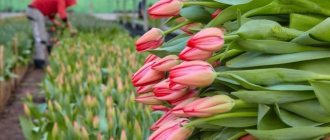Tulips are considered a symbol of femininity and remind us of the arrival of spring. They abound on store shelves on March 8th. Traditionally, these are the flowers that men give to the fair sex on International Women’s Day.
In most of our country, at the beginning of spring it is too cold outside to grow everyone's favorite flowers. For the holidays, they are bred in greenhouse conditions. This is a profitable seasonal business - all grown plants are sold out in just 1-2 days. Growing flowers for sale requires knowledge of the technology of forcing tulips by March 8 in a greenhouse. Without this, it will not be possible to obtain formed buds on the desired day.
Pros of a greenhouse
Growing tulips in a greenhouse is not a difficult task if you know the technology and strictly follow it. If you love these flowers and want to make money, then greenhouse growing is for you. If you like to tinker with flowers at all, breeding is something you can start with and make it your hobby.
This method of growing allows you to get flowers at any time of the year, and even just in time for the holidays, when they are traditionally in demand . In order to obtain beautiful and varied flowers, several conditions must be met. This is the choice of variety, planting material and compliance with the technology of growing tulips in a greenhouse.
Find out all about how to make a holiday bouquet varied and please your loved ones with fresh flowers from the greenhouse. We bring to your attention detailed materials on how to grow roses and chrysanthemums in a greenhouse.
What documents are needed?
For such a business to be legal, you need to remember where to start organizing the project. One of the first stages is legal registration with government agencies. There are no particular difficulties foreseen for growing flowers.
First, submit the standard package of documents for registration of an individual entrepreneur (individual entrepreneurship):
- passport;
- identification code;
- statement;
- receipt of payment of state duty.
The OKVED code is selected according to the direction - 01.19 - cultivation of other annual crops. Please note that in another season, in the same greenhouses and according to the same code, you can grow other crops, for example, vegetables. The tax system can be general or simplified.
Planting material
How to grow tulips in a greenhouse? To obtain strong, beautiful flowers, it is important to choose and prepare planting material . Where can I get the bulbs? Tulip bulbs are now sold in stores, nurseries, or simply by private individuals - gardeners who breed them.
The best time to buy bulbs is from July to mid-September. These are guaranteed to be the current year's bulbs . Moreover, the sooner you do this, the better quality planting material you will receive before it is taken apart by more efficient flower growers.
What to look for when buying bulbs:
- density and thickness of scales . If it is very dense and dark brown, this may be a sign that it has been left in the soil for too long;
- the ideal onion in diameter is 3.5-4 cm. You can take a slightly smaller size, but be sure to have a healthy onion;
- appearance. The bulb should be undamaged, without traces of mold, growing into the stem (only its small nose should stick out);
- condition of the lower part . There should only be tubercles from which roots will grow, the bottom should be dense;
- bulb weight. If the onion seems light for its size, it means it is rotten.
To avoid purchasing low-quality planting material, you can grow the bulbs yourself . It is best to take them from flowers growing in open ground. To do this, 2-3 days after the start of flowering, the blooming flowers need to be cut off.
Do not cut off the buds , this may stop the growth of the foliage and reduce the accumulation of necessary organic substances.
It is necessary to dig up the bulbs at the end of June - beginning of July, after 2/3 of the stem and leaves turn yellow. Only round-shaped bulbs measuring 3.5-4 cm in diameter are suitable for forcing (smaller sizes are acceptable).
Sort the onions by size: 1st analysis - the largest, 2nd analysis - smaller, etc. Peel them off to make sure they are healthy. In addition, the peeled ones receive more nutrients and moisture.
How to store bulbs?
The quality of future flowers depends on proper storage . In order for the organs to form in the bulb and the substances necessary for growth and subsequent flowering to accumulate, the bulbs are stored for the first month at a temperature of 20°C, then it can be reduced to 17°C.
Humidity is no less important than temperature; the bulbs should not dry out. Keep the level at least 70-75% . Containers should be ventilated, for example, boxes with a mesh bottom.
Financial part
For a project to be profitable, you need to think through and draw up a competent business plan in advance. To do this, it is worth calculating in detail all the costs of organizing the business.
| Investments | Amount, in rubles | |
| 1 | Business registration | 800 |
| 2 | Greenhouses | 100 000 |
| 3 | Equipment, inventory | 120 000 |
| 4 | Purchase of the first batch of bulbs | 450 000 |
| Total: | 670 800 |
But that's not all the costs. After all, monthly maintenance of the greenhouse also requires money.
| Current expenses | Amount, in rubles | |
| 1 | Public utilities | 5 000 |
| 2 | Fertilizers, fungicides | 3 000 |
| 3 | Taxes | 2 700 |
| Total: | 10 700 |
These indicators are presented on the basis that the total area of greenhouses reaches 150 square meters. m., on which 30 thousand bulbs need to be planted. Remember that about 10% of them will not sprout. Therefore, you should expect about 27,000 finished plants in the end.
Even if you sell them at a wholesale price of 40 rubles per piece, your income will be 1,080,000. And for the first season, the net profit is 398,500 rubles. With subsequent forcing, you can achieve higher performance, since you do not have to equip greenhouses from scratch.
If we add other vegetables, flowers, and plants that require similar conditions to this area, then the business will not be seasonal, but permanent. This will significantly increase your annual profit and make you a successful entrepreneur.
Video: growing tulips.
Planting for forcing
How to grow tulips in a greenhouse? Before planting, the bulbs should be kept at a temperature of +9°C for two weeks. Peel the onions to give maximum access to nutrients. If there is a lot of planting material, clean only the root tubercles.
To prevent possible infections, the bulbs need to be treated before planting. For disinfection, simply hot water can be used, but not more than 40°C . A solution of potassium permanganate (weak) or a decoction of celandine is also suitable.
The substrate is poured into the planting containers in a layer of at least 10 cm. The bulbs are buried 3-4 cm with light pressure and covered with substrate on top.
The tulip is remarkable in that it does not require powerful lighting . The planting density can be 250-300 pieces per 1 square meter. m. Planting can begin from the end of August. Its time depends on the date by which you want to receive blooming tulips.
The soil
The traditional substrate for tulips is a mixture of sand (river) and sawdust. Flowers are quite tolerant of a lack of nutrients, but do not tolerate excess moisture at all. Therefore, the soil must be well drained. To disinfect it, it would be a good idea to steam it at 80°C and spray it with a fungicide. The acidity of the soil should be neutral.
Cooling
Containers with planted bulbs are kept at a temperature of 7-9°C for 13-20 weeks.
Cooling is necessary for rooting , shoot growth and accumulation of the substance responsible for stem growth. By the end of cooling, the plant should produce a stem 5-7 cm tall.
During this time, the seedlings are watered, and the desired humidity level is established in the room. To maintain a high level of humidity in the greenhouse, you need to water the floor and walls twice a week. During cooling, lighting should be minimal , it is best to keep the room dark.
Suitable varieties of tulips for growing in a greenhouse
Before you start growing tulips in a greenhouse, you should choose the varieties that are best suited for this purpose:
- Maureen . It has buds of a classic shape with a height of 8-10 cm and a diameter of 10-12 cm. Their main color is white and only at the base it turns into cream. The stems are straight and thick, reaching 50 cm.
- Kis Nelis. It has large buds of a classic shape. Their height varies between 10-12 cm and diameter 11-14 cm. The buds do not open completely during flowering. The bottom part is painted bright pink, and the edges have a rich yellow tint. The stems are thick, straight, reaching 60 cm. The foliage has a reddish tint.
- Oxford. The goblet-shaped buds have a diameter of 8-10 cm. The petals are bright red. The inside of the base has a yellow-green tint. The variety is immune to viral diseases.
- Vivex. The bud has an elongated goblet shape. Does not open up in the sun, remaining graceful until it fades. Each petal features a combination of rich coral, pale red-orange and pink stripes. The base of the flower is yellow.
- Eric Hofsue . Large, heavy buds are goblet-shaped. Flowers do not open when exposed to the sun. Petals are crimson with cream edges. Sturdy stems reach a height of 75 cm.
- Parade record. Large goblet-shaped petals are bright red. The base of the buds is yellow with black spots. The stem is strong and tall.
- Aristocrat. Large buds are goblet-shaped. The flowers are light blue, gradually turning white.
Forcing tulips
The cooling period is over, the actual distillation begins.
Temperature
How to drive out tulips in a greenhouse? Begin to gradually raise the temperature in the greenhouse. For several days it should remain at 12-14°C, then increase to 16-18°C during the day and 14-15°C at night. When the buds appear, you need to reduce the temperature to 15°C . This will make their color more saturated, the stems stronger and longer. If you need to speed up flowering by 2-3 days, you can increase the temperature to 20°C.
Lighting
During the first days of forcing, there is no need for much lighting. With a sprout height of 6-7 cm, the lower illumination threshold will be 900 lux. In February, tulips need to extend daylight hours to 10-12 hours with the help of phytolamps placed half a meter above the plantings.
Watering
Plantings are watered early in the morning every day. Use cold water (+8-12°C). Melt water containing a minimum amount of impurities is very good. Avoid getting water on the leaves. During the first week, regular watering can be alternated with a solution of calcium nitrate (0.2%).
Top dressing
The forcing period is too short to fully fertilize the soil - it will not have time to be absorbed. You can feed it a couple of times with a special liquid fertilizer for bulbous plants.
Forcing tulips in a greenhouse by March 8
How to grow tulips in a greenhouse by March 8? If you grow tulips in a greenhouse, it would be a shame not to have them bloom in time for the “tulip” holiday itself – March 8th. For beginners, growing tulips in a greenhouse by March 8th is the first serious test of being on time.
It is necessary to time the bookmark in time . How long do tulips grow in a greenhouse? Calculating the time for laying bulbs for cooling is simple. You need to cut flowers on March 7th. Subtract 21 days from this date - this is the time of growth in the greenhouse, and again subtract 16 weeks from the resulting date - the time of cooling and germination of the bulbs. As a result, it turns out that you need to plant the bulbs on October 26th .
Comments (2)
Veronica
10/22/2017 at 06:30 |
When I was only growing tulips for the first year, I encountered such a problem as pale, colorless buds. After consulting with knowledgeable friends, I found out that it was too hot in my greenhouse and there was not enough sunlight.Answer
Yulia Expert Plodogorod
06/24/2019 at 23:21 |
Hello, Veronica! There are several other reasons that can lead to the described problems and loss of decorativeness of the buds.
First of all, sharp temperature fluctuations are unacceptable at all stages of cultivation. Such disasters can lead to many problems during further cultivation.
Deformed buds on short stems may occur if the bulbs have not been cooled properly.
Temperature is important not only after sprouts appear and flowers begin to actively develop, but also during rooting. The optimal temperature for the rooting process is 9-10 degrees. If the room is colder, this provokes the problem described - pale and unevenly colored buds.
Thin and inconspicuous petals may appear as a result of a lack of nutrients. Namely calcium. To prevent this from happening, we recommend watering the plant with calcium nitrate during the period of active growth. The procedure must be carried out at least 2 times. Concentration 1 tablespoon per ten-liter bucket.
Defects on foliage and petals are often caused by disease. Various fungal diseases usually develop due to excess humidity in the greenhouse. To avoid this, you need to install good ventilation in the room.
We would like to note that musty air and lack of normal ventilation can also cause the pale color of the buds. But if there is poor ventilation, this may not be the only problem. Flowers may even die, and in addition, such an environment promotes the development of diseases.
As for lighting, you are absolutely right; poorly lit plants produce weak peduncles and pale buds. We would like to note that when forcing any flowers you need to use phytolamps. Since the daylight hours at the end of winter and early spring are not long enough for heat-loving crops.
Answer
How to cut?
Cutting tulips, it turns out, is not such a simple matter . The further development of the bulb, which will be used as planting material for the next season, depends on it.
If you cut too low and do not leave enough leaves, this will affect the accumulation of necessary mineral salts for the further development of the flower.
The bulb shreds and becomes unsuitable as planting material. For cut tulips, it is better to take varieties with a long stem . If the issue of planting material is not an issue at all, then it is better to pull out the plant along with the bulb.
A bouquet of tulips in a vase with whole, well-washed bulbs is now considered a fashionable design move. Needless to say, this will significantly extend the life of cut flowers .
Briefly about the origin of tulips
Some flower growers believe that tulips were first bred in Holland, but the birthplace of these flowers is Persia. The ancestors of today's tulips are wild tulips that grew in the countries of Central Asia. Over time, this amazingly beautiful flower began to roam all over the world, winning the hearts of flower growers. In the east, the tulip was considered a symbol of love and was actively grown in the flowerbeds of nobles and sultans. Images of tulips can often be found on fabrics, carpets, and wall paintings. However, the flower settled in Europe a little later. The famous Austrian politician Busbeck brought the tulip bulbs. In the second half of the 16th century, the tulip gained its position and became the most common flower, which was actively selected. The first tulip bulbs were brought to Russia during the reign of Peter the Great, as a gift, and at the end of the 19th century, they became available to nobles.
Variety selection
Varieties of tulips for forcing are selected depending on the required flowering time and purpose - for breeding or for sale .
There are varieties of early, medium and late forcing. Recommended varieties for early forcing (late December), simple early class:
- Abba;
- Primavera;
- Zorro;
- Apricot beauty;
- Sunrise;
- Christmas Marvel.
For the average forcing ( from February 14 to 23 ), Triumph class:
- Kiss Nellys;
- Carola;
- Yearning;
- Abu Hassan;
- Gander.
For late forcing, varieties from the class of Darwin hybrids are recommended ( by March 8 ):
- Carnaval de Nice;
- Aristocrat;
- Parade;
- Davenport;
- Flaming Parrot.
In fact, there are a huge number of varieties ; you can choose the most beautiful ones from catalogs with descriptions.
Review of greenhouses with opening roof 2022.
Today we will conduct a comparative review of new greenhouses with a sliding roof and with opening sides.
For comparison, we have selected the ten most popular greenhouses with an opening top on the Russian market:
- "Marusya"
- «Tulip»
- «Kremlevskaya-Rublevskaya»
- "Orion"
- "Delta"
- "Flora-Cabriolet"
- "Nurse-Clever"
- "Helper-Gardener"
- "Sesame"
- "Sim-Sim"
- "Gift"
Comparison information is taken from manufacturers' official websites and verified consumer reviews.
All greenhouses are sorted in ascending order by the cost of a 6-meter long frame for the period 2018-2021. Some models cannot be installed without a foundation, so we have added the cost of the foundation and lugs to the price.
So, let's move on to our competitors.
Greenhouse "Marusya"
, Moscow city. No foundation required. Square profile 40x20, 25x25 and 20x20 mm. The price of the frame is 18,800 rubles.
Advantages: Equipped with 4 mm Premium polycarbonate. density 0.7 kg/m2 with effective UV protection on the surface, service life 15-20 years. The width of the expanding polycarbonate sheet is 1 meter; if desired, it can be reduced to 50 or 70 centimeters. The frame does not rust, is made of galvanized square pipe. The design allows the installation of automatic vents. Inexpensive, repairable polycarbonate guides with UV protection. Collapsible, convenient for transportation.
Disadvantages: Difficulty in self-installation.
"Orion"
, Dubna. No foundation required. Metal square 25 mm. Price – 20500 rub.
Advantages: Has been in production for over 5 years, has good user reviews. We offer 4 mm “Premium” class polycarbonate with a density of 0.7 kg/m2, service life 15-20 years. Rubber seals included. The width of the sliding part is 1 meter. Galvanized. Polycarbonate guides. Collapsible, easily fits in a car.
Disadvantages: Difficulty in self-installation.
Delta
, Dubna. The roof is removable. No foundation required. Profile 20 mm. The price of the frame is 21,900 rubles.
Advantages: Galvanized. Polycarbonate 4 mm Premium with a density of 0.7 kg/m2, service life 15-20 years. Rubber seals included. “House” shape with straight walls. Polycarbonate runners. Collapsible, takes up little space.
Disadvantages: The complex roof structure, which consists of two parts and is latched in the middle, requires additional time to assemble it yourself. It is demanding on the condition of the soil; when installed on a heaving and swampy area, it is better to mount it on a foundation. In summer, it should not be opened more than 20 cm.
Greenhouse Flora-Cabriolet
, Vladimir region. The frame is galvanized or painted. Profile 20 mm. The roof is removable. A foundation is required. The frame costs 22,300 rubles. + foundation for 4000 rub.
Advantages: Straight walls. You can order a galvanized frame.
Disadvantages: The painted frame will rust over time. Welded, welding seams rust. High walls have greater windage. Bulky, inconvenient to transport in a car. Not convenient to use. The edges of the removable roof are located at a height of 2 meters, making it difficult for short people to use. Before winter, it is necessary to completely remove the roof and put it away, and in the spring, insert a long three-meter sheet into the guides in place; this requires two tall people and a free space of 2-3 meters on one side. The length of the polycarbonate sheet on the roof is 3 meters; you need to have a free space of 2-3 meters on one side to use it. In summer, the sheets cannot be extended more than 20 cm, otherwise the wind will fray the free ends and may even tear them out of the guides or break them. There are no seals, the heat will escape through the cracks. The kit does not include high-quality, durable polycarbonate. Greenhouses “Flora Cabriolet” are equipped only with cheap polycarbonate from the KS Profplast plant without UV protection on the surface in the form of a film, but only “in bulk”. Such polycarbonate can be destroyed by the sun within 5 years. The walls are covered with weak, “lightweight” polycarbonate with a reduced density. Difficulty in self-assembly.
Greenhouse "Kremlevskaya Rublevska" with opening roof and sides.
Production "New Forms", Kimry. Installation on a foundation or on piles. Double profile 20x20 mm. The price of a frame of 6 meters is 24,300 rubles. + pine foundation 3000 rub. + lugs 1 set (4 pcs.) 600 RUR, you need to buy at least 2 sets.
Advantages: Galvanized frame. There is a wide selection of SPK varieties; the assortment also includes expensive, high-quality polycarbonate, just suitable for sliding greenhouses.
Disadvantages: The Rublevskaya greenhouse with a sliding roof and sides is a simplified version of the Kremlevskaya greenhouse, it has only three longitudinal lintels. Mounting on "crabs". The opening sides and 2-meter-wide sliding roof have a large windage area; strong winds can tear the soft polycarbonate out of the guides, making it difficult to insert back. When polycarbonate moves up and down, the protective layer from ultraviolet radiation on the lower sheets can be worn off due to friction, which will lead to its rapid deterioration. When condensation forms on the inner surface of the greenhouse, the wide sheets of SPC stick, and the sides will not rise until the top dries. The rising sides are quite heavy for older people. Difficult to assemble.
Greenhouse Botanist "Tulip"
Manufactured by AGS-Service, Minsk. The top and sides move apart. Installed on the foundation or on piles. Profile 40x20 mm. The cost of the frame is 25,700 rubles. + 3000 timber foundation + lugs.
Problems during cultivation
Problems in forcing can arise if its rules .
- The buds look like paper. Reduce the temperature and ventilate the greenhouse regularly.
- Drooping flowers indicate too high a temperature.
- Weak peduncles - night temperature exceeds daytime, lack of calcium.
- Poor rooting of bulbs - too low humidity .
- Bulbs rotting after planting - soil that is too warm.
- Pasture only a leaf without a peduncle - the bulbs are planted too small.
Useful tips and possible difficulties
When growing tulips, problems may arise:
- The buds are dry, feel like paper, or the petals are too thin. The reason is poor air exchange or too high a temperature. To correct the situation, ventilate the greenhouse and reduce the temperature in it.
- Drooping buds. This is a sign of high temperature in the greenhouse. Cooling the room will help save the plant.
- Peduncles are weak. This happens if tulips do not have enough calcium or the night temperature is higher than the day temperature. In case of a similar problem, plants are fed with 0.2% calcium sulfate and the temperature is normalized.
- The bulbs do not take root. This occurs when indoor humidity is low. If the problem remains relevant when the walls of greenhouses are sprayed daily, then an air humidifier will have to be installed in the room.
- Bulb rotting. The problem lies in elevated soil temperatures. This happens if the tulips are watered with insufficiently cold water.
- The greenery grows, but flower stalks do not appear. This happens if the planting material was too small.
The flowering of tulips will be accelerated by watering with water at room temperature (+20°C). This is done 3 days before the buds appear.
It is important that water does not get on the leaves of tulips and buds. They are watered at the root. Moisture on greenery will cause plant disease.
Note! Most growing problems arise when the temperature regime is not maintained. It is very important that the temperature indicators of the room and water correspond to the norm.
Determination with cultivation method
There are 2 most common methods of growing tulips:
Traditional - when the bulbs, planted and watered, are stored at a temperature of 12 degrees, when a 10 cm sprout appears, they are transferred to a warm place, where the temperature gradually rises to 18 degrees.
Regular watering and lighting are observed when sprouts appear, up to 6 hours a day.
Dutch - strict adherence to temperature indicators is a much more expensive matter:
- 12 weeks before planting at 5 degrees.
- After planting, store in a cold room with a humidity of 90%.
- For rooting to occur, the air temperature should be about 13 degrees and the soil 11.
- Then it rises to 18 degrees.
- When the bulbs have sprouted, remove the unsprouted material to prevent mold from appearing.
Harvesting
A properly harvested harvest is half of a successful business; there are a certain number of nuances:
- When the buds are still green, the flowers are pulled out directly from the bulb and placed vertically.
- Cutting is done early in the morning at a temperature of 12 degrees, when the bud is half colored.
- Flowers that are ready for sale are stored at 2 - 3 degrees, so they will retain their presentation for a month.
- Before the sale itself, the temperature is raised and the flowers are sorted into boxes. Sometimes the bulbs are left, this adds emphasis to the appearance of the product. They last longer for the client, but their price is much higher
Proper care is the key to high profits
For a business to give positive results it is necessary:
- Before planting, peel the bulbs;
- During planting, the temperature in the greenhouse should be 9 degrees;
- A square meter can hold at least 350 bulbs;
- The ground is always wet, but not flooded;
- 2 weeks after forcing, increase the temperature to 18 degrees;
- Constantly monitor the plants; immediately remove spoiled or ungerminated ones;
- Maintain humidity conditions;
- Cut flowers before the buds open.
Expense calculations
For example, profit is expected from 2000 bulbs, for this you need:
- 25 boxes, which is approximately 500 rubles;
- 2000 bulbs at an average price of 15 rubles - 30,000 rubles;
- A greenhouse with this amount of material is 6 sq. m – from 12,000 rubles;
- Electricity consumption for additional lighting for 12 hours a day for 52 days is about 300 kW, which is an average of 1000 rubles;
- Heating - here it all depends on the method used, but if we take the conventionally electric method, then on average it will be 2 times higher than lighting, and that’s 2000 rubles;
- Mesh for boxes – 600 rubles;
- If you sell it yourself, then the cost of packaging and film will be about 1,500 rubles.
Total:
500+30 000+12 000+1000+2000+600+1500
It comes out to about 48,000 rubles.
Digging up bulbs for storage and replanting tulips
In order for the bulb to continue to delight you with large buds and flowers, it is very important to prevent the tulip from developing seed material. If the tulip does develop a seed box, remove it as soon as possible. Do not touch the leaves of the plant, because the bulb receives nutrition from them.
So that the tulips do not become smaller, and the soil can gain strength for subsequent planting and get rid of pests, flowers are dug up every year and stored in a cool room. However, if the tulip is planted in well-drained and nutritious soil, and deep enough, then with annual feeding it can be left for 3-5 years in the same place. However, after three years, the tulips should still be transplanted to a new place; this is done in order to separate the children from the mother’s bulb, inspect for diseases, and also give the area time to rest. Therefore, in July, when the leaves begin to wither and turn yellow, the bulbs are dug up, cleared of the ground, dried in a well-ventilated area, without exposure to sunlight, sorted into paper boxes or drawers and thus stored until the next planting in a cool and well-ventilated area .
Many gardeners plant tulips as early as September so that the bulb can take root before frost sets in. Because otherwise, she will simply freeze. Choose a suitable place, well-warmed by the sun and not subject to stagnant water. Form beds, the recommended depth of which is about 20 centimeters, then add superphosphate, drain the trench with a thin layer of sand, this will protect the bulb from rotting during heavy rains. It is better not to add manure, tulips do not like it, it can lead to rotting of the bulb.
Planting is done approximately in this order: large bulbs are planted bottom down, at a distance of 20 cm from each other, then small bulbs are planted between them and covered with soil. With this planting scheme, there is no need to replant the bulbs annually. If the winter in your region has little snow and frost, then tulips should be planted deeper and be sure to mulch, and when the low temperature recedes, collect the mulch so that the soil warms up evenly. Also, by mulching and controlling snow cover in the area, you can shift the flowering time of flowers. In general, tulips survive temperatures that are not too low without consequences. Therefore, in the southern regions, there is no reason to worry about your flower bed. However, if the temperature drops below -25 degrees, there is a threat of losing your flower plantings; for this, the beds must be covered and insulated. The best insulation in the beds is chopped straw, peat, sawdust, and on top of the mulch is covered with a layer of snow and frosts are not scary for tulips.
Monitoring the development of tulips
Tulips need attention, and it does not always have to be in standard procedures. These bulbs need to be monitored, noticing the first signs of developmental disorders, health problems or uncomfortable conditions. Regular inspection of leaves, flowers, and peduncles will prevent any troubles at an early stage.
The most important procedure in monitoring tulip plantings is considered to be the spring one. After the plants begin to actively develop, they need to be monitored. Typically, the first assessment is made as soon as the soil has warmed and the first shoots have appeared, noting signs of stunted growth and removing plants that do not germinate. At the slightest sign of plant damage by diseases, such specimens are immediately destroyed and removed not only along with the roots, but also along with a fairly large lump of earth. After removing diseased tulips, treat the soil with a fungicide, at least a solution of simple potassium permanganate, to prevent the spread of diseases.
Inspections continue throughout the active growing season and flowering. Specimens affected by viruses and diseases are carefully removed, trying not to damage neighboring plants. A particularly thorough assessment is always carried out after flowering. But if you collect tulips and carefully control their varietal identity, then varietal cleaning should be carried out at the height of flowering, noting questionable specimens and impurities, in order to then separate the plants and restore varietal purity.
Any parts of tulips dug up due to suspected infection, as well as dry parts of plants, are not sent to compost, but destroyed.
Trimming tulip stems and leaves. ©Indie











